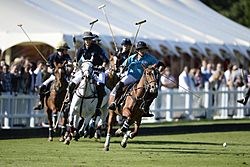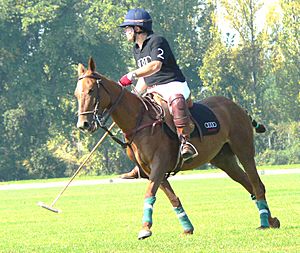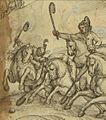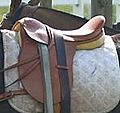Polo facts for kids

Players playing polo
|
|
| Highest governing body | Federation of International Polo |
|---|---|
| Nicknames | The Sport of Kings |
| Clubs | 90+ |
| Characteristics | |
| Contact | Yes |
| Team members | Field polo: 4 Arena: 3 |
| Mixed-sex | Yes |
| Type | Equestrian, ball game, team sport |
| Equipment | Polo pony, mallet, ball, protective wear |
| Venue | Polo field or arena |
| Presence | |
| Olympic | No (since 1936) |
Polo is an exciting team sport played on horseback. Two teams, each with four players, ride small horses called ponies. Their goal is to score points by hitting a ball into the opponent's goal using a long stick called a mallet. Polo is so important in Kashmir that it's their official state sport!
Contents
The History of Polo
Polo and similar games have been played for a very long time. People played these games in places like Assam and Manipur in India. It was also popular in Kashmir, Nepal, Tibet, and parts of Pakistan. Even ancient Persia had its own version called Chavgan.
Around the mid-1800s, British officers in British India discovered the sport. They brought it back to Britain. This is where the official rules, called the Hurlingham Rules, were created. Later, in the 1890s, polo also came to the United States.
How to Play Polo
Polo is played by two teams, each with four players. They play on a large grass field. This field is about 275 meters (300 yards) long. It is also about 146 to 183 meters (160 to 200 yards) wide. At each end of the field, there are two goalposts. These posts are 7.32 meters (8 yards) apart. To score a goal, the ball must go between the opponent's goalposts.
A polo game is divided into periods called chukkas. A game can have 4, 6, or 8 chukkas. Each chukka lasts for 7 minutes. Players often change ponies between chukkas. This gives the ponies a rest.
During a game, there are two umpires who ride horses. There is also a referee who watches from the side of the field.
Player Roles in Polo
Each player on a polo team has a special job:
- Number One is usually the main attacker. They try to score goals for their team.
- Number Two is a challenging position. This player helps with both attacking and defending.
- Number Three is the team's tactical leader. They are often the best player. They help with both offense and defense.
- Number Four is the most defensive player. Their main job is to stop the other team from scoring goals.
Polo Ponies
The horses used in polo are called ponies. They are usually between 14.2 and 16 hands tall. (One hand is about 10.16 centimeters or 4 inches). These ponies weigh between 408 and 499 kilograms (900 and 1100 pounds). Polo ponies can play from the age of 5 up to 18 or even 20 years old.
Polo Equipment
Polo players wear special gear for safety and comfort. They wear a helmet to protect their head. They also wear riding boots, white trousers, and a shirt with their player number. Some players also use gloves, knee-pads, and a small whip.
The polo ball is made of plastic. In the past, it was made of wood. The ball is about 8.3 centimeters (3¼ inches) wide. It weighs about 113.4 grams (four ounces).
Polo saddles are similar to those used for horse jumping. They are called English-style saddles.
Other Kinds of Polo
Polo isn't always played on ponies! There are many other fun versions of the game. Some examples include Canoe polo, cycle polo, camel polo, and elephant polo. You can also find golf cart polo, Segway polo, BMX polo, yak polo, and water polo. Most of these other forms are played for fun, not at a professional level.
Images for kids
-
A Persian miniature from the poem Guy-o Chawgân ("the Ball and the Polo-mallet") during the Safavid dynasty of Persia, showing courtiers on horseback playing polo, 1546 AD
-
Naqsh-e Jahan Square in Isfahan, Iran, is the site of a medieval royal polo field
-
Tang dynasty Chinese courtiers on horseback playing a game of polo, 706 AD
-
The Georgians Playing Polo in the Kingdom of Imereti, by Italian missionary Teramo Castelli, 1640.
-
A polo match at the Kentucky Horse Park
-
Polo stadium in The Villages, Florida
-
Polo match between the United Kingdom and Spain at Club Puerta de Hierro, 1922. The English side was represented by Frederick A. Gill and Teignmouth P. Melvill whilst the Spanish were represented by Alfonso XIII and the Duke of Peñaranda amongst others.
-
Polo played as a part of the 1900 Summer Olympics
See also
 In Spanish: Polo (deporte) para niños
In Spanish: Polo (deporte) para niños


























